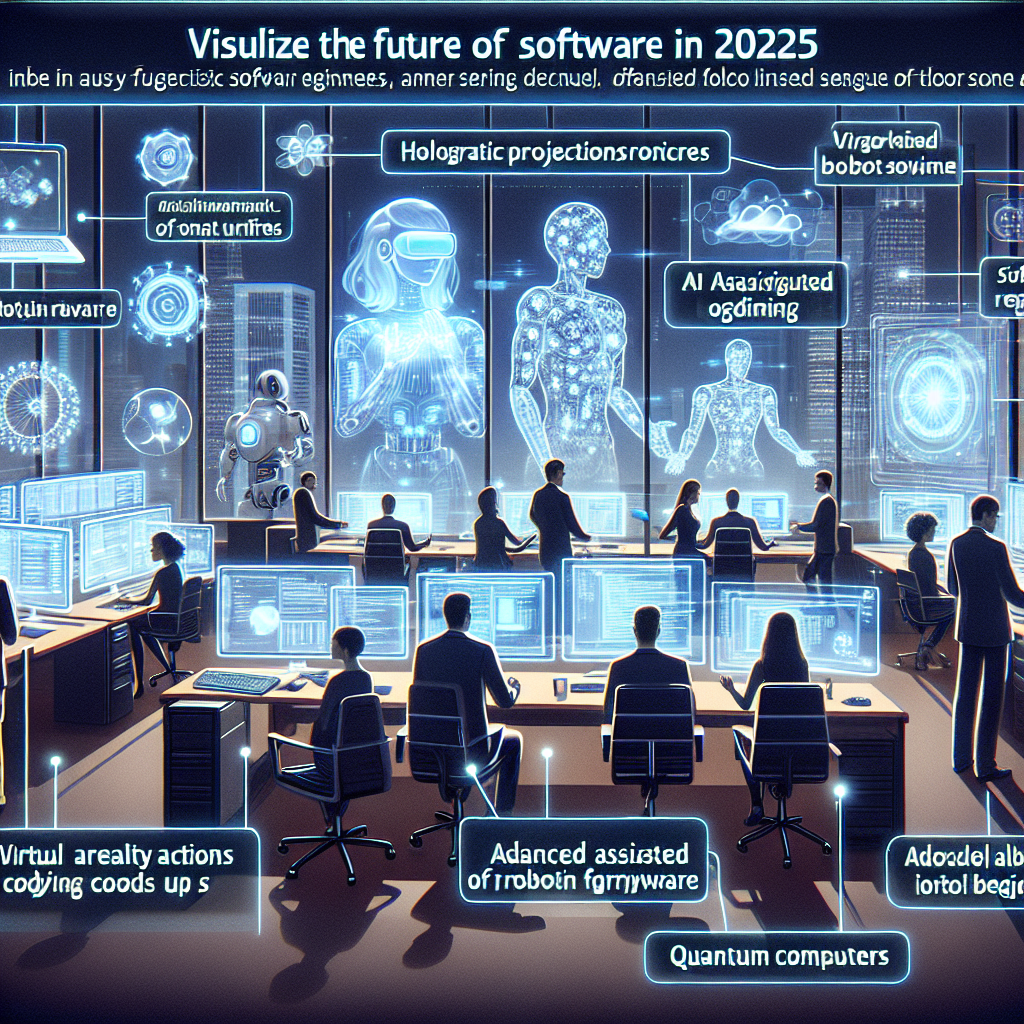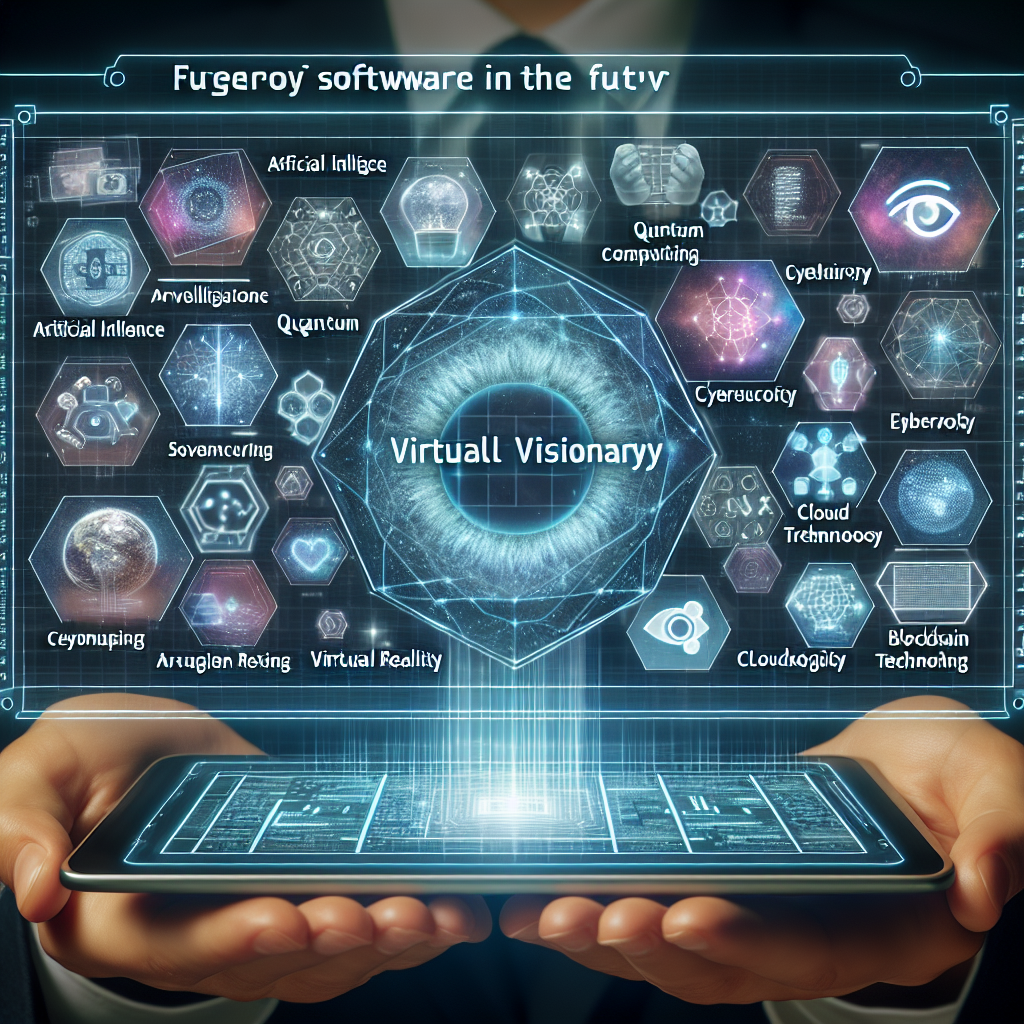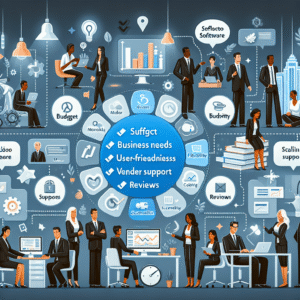-
Table of Contents
Artificial Intelligence Integration in Everyday Applications
As we approach 2025, the integration of artificial intelligence (AI) into everyday applications is poised to revolutionize the software industry. This transformation is not merely a trend but a fundamental shift in how software is developed, deployed, and utilized across various sectors. The increasing sophistication of AI technologies is enabling applications to become more intuitive, efficient, and personalized, thereby enhancing user experience and operational efficiency.
One of the most significant developments in this area is the rise of AI-driven automation. Businesses are increasingly leveraging AI to automate routine tasks, which not only reduces operational costs but also minimizes human error. For instance, AI-powered chatbots are becoming ubiquitous in customer service, providing instant responses and solutions to customer queries. This not only improves customer satisfaction but also allows human agents to focus on more complex issues that require a personal touch. Moreover, AI is being integrated into enterprise resource planning (ERP) systems, enabling companies to optimize supply chain management, inventory control, and financial forecasting with unprecedented accuracy.
In addition to automation, AI is enhancing the personalization of applications. By analyzing vast amounts of data, AI algorithms can tailor content and recommendations to individual users, thereby creating a more engaging and relevant experience. This is particularly evident in the retail and entertainment industries, where AI is used to analyze consumer behavior and preferences, offering personalized product recommendations and content suggestions. As a result, businesses can foster stronger customer relationships and drive higher engagement and sales.
Furthermore, the integration of AI into everyday applications is driving advancements in predictive analytics. By harnessing the power of machine learning, applications can now predict future trends and behaviors with remarkable precision. This capability is invaluable for businesses seeking to make data-driven decisions. For example, in the healthcare sector, AI-powered applications can predict patient outcomes and suggest personalized treatment plans, thereby improving patient care and reducing costs. Similarly, in finance, AI is used to predict market trends and assess risks, enabling more informed investment decisions.
As AI continues to evolve, ethical considerations are becoming increasingly important. The integration of AI into everyday applications raises questions about data privacy, security, and bias. Businesses must ensure that their AI systems are transparent and accountable, with robust mechanisms in place to protect user data and prevent discriminatory outcomes. This requires a concerted effort from developers, policymakers, and industry leaders to establish ethical guidelines and standards for AI deployment.
Moreover, the integration of AI into everyday applications is reshaping the workforce. While AI-driven automation may displace certain jobs, it also creates new opportunities for skilled workers who can develop, manage, and maintain these advanced systems. Consequently, there is a growing demand for professionals with expertise in AI and machine learning, prompting educational institutions to adapt their curricula to meet this need.
In conclusion, the integration of artificial intelligence into everyday applications is set to redefine the software landscape by 2025. Through automation, personalization, and predictive analytics, AI is enhancing the functionality and efficiency of applications across various industries. However, as we embrace these advancements, it is crucial to address the ethical and workforce implications to ensure that AI serves as a force for good. As businesses and individuals navigate this transformative era, the potential for innovation and growth is boundless, heralding a future where AI is seamlessly woven into the fabric of our daily lives.
The Rise of Quantum Computing in Software Development
As we approach 2025, the landscape of software development is poised for a transformative shift, driven by the rise of quantum computing. This emerging technology, once the realm of theoretical physics, is now making tangible inroads into the world of software, promising to revolutionize how we approach complex computational problems. Quantum computing, with its ability to process information in fundamentally different ways than classical computers, offers unprecedented opportunities for software developers to tackle challenges that were previously deemed insurmountable.
At the heart of quantum computing’s potential is its use of qubits, which, unlike classical bits, can exist in multiple states simultaneously. This property, known as superposition, allows quantum computers to perform many calculations at once, exponentially increasing their processing power. As a result, software developers are beginning to explore new algorithms and applications that leverage this capability, particularly in fields such as cryptography, optimization, and machine learning. For instance, quantum algorithms have the potential to break traditional encryption methods, prompting a reevaluation of cybersecurity protocols and the development of quantum-resistant algorithms.
Moreover, the concept of entanglement, another quantum phenomenon, enables qubits that are entangled to be correlated with each other, regardless of the distance separating them. This property can be harnessed to create highly efficient communication networks and distributed computing systems, which could redefine the architecture of software applications. As developers begin to integrate these quantum principles into their work, we can expect to see a new class of software that is not only faster but also more secure and capable of solving problems that are currently beyond the reach of classical computing.
However, the integration of quantum computing into software development is not without its challenges. The technology is still in its nascent stages, and significant hurdles remain in terms of hardware stability, error rates, and scalability. Despite these obstacles, major tech companies and research institutions are investing heavily in quantum research, driven by the promise of its transformative potential. As these efforts bear fruit, we can anticipate a gradual but steady incorporation of quantum computing into mainstream software development practices.
In addition to technical challenges, there is also a pressing need for a new generation of software developers who are well-versed in quantum principles. Educational institutions are beginning to recognize this need, incorporating quantum computing into their curricula to prepare students for the demands of this emerging field. As the workforce becomes more adept at understanding and applying quantum concepts, the pace of innovation in software development is likely to accelerate.
Furthermore, the rise of quantum computing is expected to foster greater collaboration between industries and academia. As the technology matures, partnerships will be crucial in driving research and development, ensuring that the benefits of quantum computing are realized across various sectors. This collaborative approach will not only facilitate the sharing of knowledge and resources but also help in addressing the ethical and societal implications of quantum technologies.
In conclusion, as we look towards 2025, the rise of quantum computing in software development represents a paradigm shift with far-reaching implications. While challenges remain, the potential benefits of this technology are immense, promising to unlock new possibilities in computation and problem-solving. As the field continues to evolve, staying abreast of these developments will be crucial for businesses and developers alike, ensuring they remain at the forefront of this exciting technological frontier.
Evolution of Cybersecurity Measures in a Digital World

As we look toward 2025, the evolution of cybersecurity measures in a digital world is poised to undergo significant transformations, driven by the rapid advancement of technology and the increasing sophistication of cyber threats. The digital landscape is becoming more complex, with the proliferation of connected devices, the expansion of cloud computing, and the integration of artificial intelligence into various sectors. Consequently, cybersecurity strategies must evolve to address these emerging challenges and protect sensitive data from malicious actors.
One of the most notable trends in cybersecurity is the shift towards a more proactive approach. Traditionally, cybersecurity measures have been largely reactive, focusing on identifying and mitigating threats after they occur. However, as cyberattacks become more frequent and sophisticated, there is a growing emphasis on anticipating potential threats and implementing preventive measures. This proactive stance involves leveraging advanced technologies such as machine learning and artificial intelligence to predict and identify vulnerabilities before they can be exploited. By analyzing vast amounts of data in real-time, these technologies can detect anomalies and patterns indicative of potential cyber threats, allowing organizations to respond swiftly and effectively.
In addition to adopting a proactive approach, the future of cybersecurity will also see an increased focus on zero-trust architecture. This model operates on the principle that no user or device, whether inside or outside the organization’s network, should be automatically trusted. Instead, continuous verification is required to access resources, ensuring that only authorized users can interact with sensitive data. This approach is particularly relevant in an era where remote work and cloud-based services are becoming the norm, as it provides a robust framework for securing data across diverse environments.
Moreover, the integration of blockchain technology into cybersecurity strategies is another trend to watch. Blockchain’s decentralized nature and cryptographic security make it an attractive option for enhancing data integrity and protecting against unauthorized access. By utilizing blockchain, organizations can create immutable records of transactions and interactions, making it significantly more challenging for cybercriminals to alter or tamper with data. This technology is expected to play a crucial role in securing supply chains, financial transactions, and identity management systems.
As cybersecurity measures evolve, there is also a growing recognition of the importance of human factors in maintaining robust security protocols. Despite technological advancements, human error remains a leading cause of data breaches. Therefore, organizations are increasingly investing in comprehensive training programs to educate employees about cybersecurity best practices and the latest threat vectors. By fostering a culture of security awareness, businesses can empower their workforce to act as the first line of defense against cyber threats.
Furthermore, regulatory frameworks are expected to become more stringent, compelling organizations to adhere to higher standards of data protection and privacy. Governments worldwide are enacting legislation to safeguard consumer data and hold companies accountable for breaches. As a result, businesses must stay abreast of these regulatory changes and ensure compliance to avoid legal repercussions and maintain customer trust.
In conclusion, the evolution of cybersecurity measures in a digital world is characterized by a shift towards proactive strategies, the adoption of zero-trust architecture, the integration of blockchain technology, and an emphasis on human factors and regulatory compliance. As we approach 2025, organizations must remain vigilant and adaptable, continuously refining their cybersecurity practices to navigate the ever-changing threat landscape and safeguard their digital assets.
The Impact of 5G on Mobile and Cloud Software
As we look toward 2025, the landscape of software development is poised for significant transformation, driven in large part by the widespread adoption of 5G technology. This next-generation wireless network promises to revolutionize the way mobile and cloud software are developed, deployed, and utilized. The impact of 5G on these domains is multifaceted, offering unprecedented opportunities for innovation while also presenting new challenges for developers and businesses alike.
To begin with, the most immediate and noticeable impact of 5G on mobile software is the dramatic increase in data transfer speeds. With speeds up to 100 times faster than current 4G networks, 5G enables mobile applications to deliver richer, more immersive experiences. This enhancement is particularly beneficial for applications that rely heavily on real-time data processing, such as augmented reality (AR) and virtual reality (VR) applications. As a result, developers are now able to create more sophisticated and responsive mobile applications that were previously constrained by bandwidth limitations.
Moreover, the low latency offered by 5G networks is a game-changer for cloud-based software. With latency reduced to mere milliseconds, cloud applications can now operate with near-instantaneous response times. This improvement is crucial for industries that depend on real-time data analytics and decision-making, such as finance, healthcare, and autonomous vehicles. Consequently, businesses can leverage cloud software to enhance operational efficiency and deliver superior customer experiences.
In addition to speed and latency improvements, 5G also facilitates the proliferation of the Internet of Things (IoT). The ability to connect a vast number of devices simultaneously without compromising performance is a hallmark of 5G technology. This capability is set to drive the development of IoT applications that can seamlessly integrate with mobile and cloud platforms. As IoT devices become more prevalent, software developers will need to focus on creating solutions that can manage and analyze the massive amounts of data generated by these devices. This shift will likely lead to the emergence of new business models and services that capitalize on the interconnectedness of devices and data.
However, the transition to 5G is not without its challenges. Security concerns are paramount, as the increased connectivity and data flow present more opportunities for cyber threats. Developers and businesses must prioritize robust security measures to protect sensitive information and maintain user trust. Additionally, the deployment of 5G infrastructure requires significant investment, which may pose a barrier for some regions and organizations. Overcoming these challenges will be essential to fully realizing the potential of 5G in the software industry.
Furthermore, the integration of 5G technology into existing systems necessitates a reevaluation of current software development practices. Developers will need to adopt new tools and methodologies to optimize applications for 5G networks. This shift may involve embracing edge computing, which brings data processing closer to the source, thereby reducing latency and improving performance. As a result, the role of software developers will evolve, requiring them to acquire new skills and adapt to the changing technological landscape.
In conclusion, the impact of 5G on mobile and cloud software is profound, offering both opportunities and challenges. As we approach 2025, businesses and developers must navigate this evolving landscape with agility and foresight. By embracing the capabilities of 5G, they can unlock new possibilities for innovation and growth, ultimately shaping the Future of Software in ways that were once unimaginable.
Advancements in Augmented Reality for Business Solutions
As we look toward the Future of Software development, one of the most promising areas of growth is the application of augmented reality (AR) in business solutions. By 2025, AR is expected to transcend its current role as a novelty in gaming and entertainment, becoming a pivotal tool in various business sectors. This shift is driven by the increasing demand for immersive and interactive experiences that enhance productivity, streamline operations, and improve customer engagement. As businesses continue to seek innovative ways to differentiate themselves in a competitive market, AR offers a unique opportunity to transform traditional processes and create new value propositions.
One of the primary areas where AR is poised to make a significant impact is in training and development. Companies are increasingly recognizing the potential of AR to provide realistic, hands-on training experiences without the associated risks and costs of real-world training. For instance, in industries such as manufacturing and healthcare, AR can simulate complex scenarios, allowing employees to practice and refine their skills in a controlled environment. This not only accelerates the learning process but also ensures a higher level of competency and confidence among employees.
Moreover, AR is set to revolutionize the way businesses approach customer service and support. By integrating AR into customer interactions, companies can offer more personalized and efficient service. For example, AR can enable remote assistance, where support agents can guide customers through troubleshooting processes by overlaying digital instructions onto real-world objects. This not only enhances the customer experience but also reduces the time and resources required to resolve issues.
In addition to training and customer service, AR is also transforming the retail sector. As consumers increasingly seek engaging and convenient shopping experiences, AR offers retailers the ability to create virtual showrooms and fitting rooms. This technology allows customers to visualize products in their own environment or try on clothing virtually, thereby reducing the uncertainty and hesitation often associated with online shopping. Consequently, AR can drive higher conversion rates and customer satisfaction, ultimately boosting sales and brand loyalty.
Furthermore, AR is playing a crucial role in enhancing collaboration and communication within organizations. With the rise of remote work, businesses are leveraging AR to create virtual meeting spaces where teams can interact as if they were physically present. This not only fosters a sense of connection among remote employees but also facilitates more effective collaboration on complex projects. By providing a shared visual context, AR can help teams overcome geographical barriers and work together more seamlessly.
As we approach 2025, the integration of AR into business solutions is expected to accelerate, driven by advancements in hardware and software capabilities. The development of more sophisticated AR devices, such as smart glasses and headsets, will make AR more accessible and practical for everyday business use. Additionally, improvements in AR software, including better tracking, rendering, and user interface design, will enhance the overall user experience and expand the range of possible applications.
In conclusion, the Future of Software in the realm of augmented reality for business solutions is bright and full of potential. As companies continue to explore and invest in AR technologies, we can expect to see a profound transformation in how businesses operate, interact with customers, and engage with employees. By embracing these advancements, businesses can not only stay ahead of the curve but also unlock new opportunities for growth and innovation in an increasingly digital world.
Conclusion
The Future of Software in 2025 is poised to be shaped by several key trends. Artificial intelligence and machine learning will continue to drive innovation, enabling more personalized and efficient applications. The rise of low-code and no-code platforms will democratize software development, allowing non-developers to create applications and solutions. Edge computing will gain prominence, reducing latency and improving real-time data processing capabilities. Cybersecurity will become increasingly critical, with a focus on proactive threat detection and response. Additionally, the integration of blockchain technology will enhance transparency and security in various sectors. As these trends converge, the software industry will experience a transformation that emphasizes accessibility, efficiency, and security, ultimately reshaping how businesses and individuals interact with technology.



